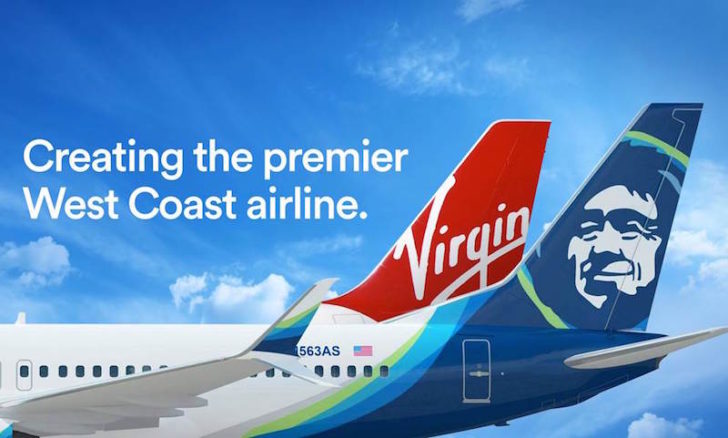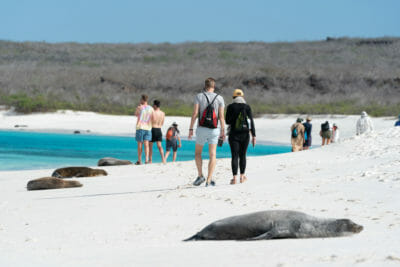With the pending acquisition of Virgin America by Alaska Airlines announced last week, we have already learned that Alaska plans to operate a single carrier with the Alaska Airlines name and loyalty program. Some people are already speculating about what will change at either carrier. I suspect most of Alaska’s policies will be adopted. It’s by far the larger carrier, it has a longer history, and — frankly — it ranks even higher than Virgin in some quality and satisfaction rankings.
But I was curious just how different these two airlines are. In some ways they are actually quite similar. Things like fees and the in-flight experience are not as different as I expected. Sometimes they’re just a different twist on the same philosophy.
Where the programs really differ, not surprisingly, are in the fundamentals of their loyalty programs. Stuff like earning and redeeming miles — but also upgrades, relationships with partner airlines, and lounge access. Things that I take for granted on Alaska, or even other carriers, don’t seem to be an option on Virgin America unless you pay for them.
Earning Miles
Alaska Airlines is the last U.S. carrier to award miles based on the distance you fly rather than the cost of your ticket. This is to the benefit of travelers who can find cheaper fares on long itineraries. However, your fare still plays a role. Alaska will award up to 175% of the distance flown if you buy more expensive refundable fares or first class fares, while keeping a minimum of 1 mile per mile flown (100%) on the cheapest coach fares.
When you travel on one of Alaska’s partner airlines, this range can vary. For example, earn between 100% and 150% of the distance flown on American, between 25% and 200% of the distance flown on Delta, and between 25% and 300% of the distance flown on British Airways. The bigger the spread, the more it favors people who buy expensive fares.
Virgin America was one of the first U.S. carriers to award miles based on the price of your ticket. This is generally a simpler method for travelers to understand, but it’s not always more rewarding. (We’ll get to that next.) You’ll get 5 points for every dollar, looking at the base fare excluding taxes and fees. So, a one-way ticket that costs $205.60 will earn 1,000 points assuming a $200 base fare, whether you travel 500 miles or 5,000.
Virgin still uses distance to calculate how many miles you’ll earn when you travel on its partner airlines. For example, earn between 40% and 65% of the distance flown on Singapore Airlines, between 10% and 60% of the distance flown on Virgin Atlantic, and between 20% and 80% of the distance flown on Emirates. Elevate points are generally worth twice as much as Alaska miles, so numbers may appear low but aren’t that bad once you double them.
Bonuses for elite status are pretty similar between programs. Silver members earn 25% more points with Virgin America, and Gold members earn 100% more. On Alaska, MVP members earn 50% more, Gold members earn 100% more, and MVP Gold 75K members earn 125% more. The biggest difference? Virgin America doesn’t award any bonus points on partner airlines.
Redeeming Miles
How many miles you earn is irrelevant unless you also consider how many miles it takes to redeem for a particular award flight. Alaska Airlines, like many other airlines in the U.S. and internationally, uses a zone-based award chart. Travel from one region to another requires a fixed number of miles independent of the actual selling price for that flight. Supply of award seats is restricted, but sometimes more seats are available for more miles. In general, this model favors customers who are flexible with their travel plans.
Virgin America uses a revenue model for its own flights, similar to one earlier adopted by Southwest Airlines. More expensive flights require more points, and less expensive flights require fewer points. And, like Southwest, Virgin doesn’t exactly stick to a single conversion rate. Here are some example fares for a flight from Seattle to Austin.
- Main Cabin: $261 or 11,624 points + $5.60 (2.20 cents per point; cpp)
- Main Cabin Select: $545 or 25,493 points + $5.60 (2.12 cpp)
- First Class: $932 or 44,393 points + $5.60 (2.09 cpp)
Let’s just call it 2.2 cents. This means your points are never worth more than 2.2 cents per point — but they’re also never worth less, excusing the minor variation observed between cabins, and you can pick any flight you want on any day assuming you have enough points. It is, in effect, a rebate system. If you earn 5 points per dollar when you buy a ticket, and those points are worth 2.2 cents, then you are receiving 11% back. Always.
Things are tricker when redeeming points on Virgin’s partners. They use a zone-based award chart similar to Alaska Airlines and its partners. One major difference is that Virgin collects carrier surcharges on all its international tickets, while Alaska only collects them for three carriers. In my opinion, I don’t think either airline can respectably collect hundreds of dollars in fees for an “award” flight. United Airlines, Virgin’s biggest competitor in San Francisco, is the only carrier I know that avoids such fees entirely.
First Class Upgrades
The most surprising thing about Elevate is that it doesn’t offer free upgrades to first class. Yes, you can upgrade from Main Cabin to Main Cabin Select, but that just gets you more legroom and a free drink. If you want first class, you still have to pay. Elite status merely opens this window earlier — and at 24 hours before departure for Gold members, it’s not a very big window. These upgrades cost between $99 and $399.
One reason I like flying Alaska Airlines is that it’s so easy to get an upgrade. Most premium and mid-priced economy fares can be upgraded at the time of booking in exchange for 15,000 miles, a complimentary upgrade voucher, or just on the basis of having elite status. Many Gold and 75K members also report high success rates on waitlisted upgrades close to departure.
Some airlines try to sell their first class seats — and that’s great. Others view them as an elite benefit. Alaska has been in the latter camp for a long time but is slowly moving towards trying to sell them. Several years ago they started offering discounted first class tickets for the first time, and recently they announced plans to remove some first class seats from their cabins even as they claim their models predict little change in upgrade rates. Virgin America is solidly in the “sell” camp. The only question is if you pay now or pay later.
Lounge Access
Alaska Airlines operates four lounges, and if you have an actual membership you can get access to dozens more. Access is complimentary to first class passengers, or day passes can be purchased by other travelers for $45.
Virgin America operates just one of its own lounges and has a partnership agreement with three others operated by Virgin Atlantic. First class passengers have the option to pay $30 to $75 for a day pass depending on location. Economy class passengers are prohibited in two locations, though elite members can buy access for $30-40 in New York. In Virgin America’s own lounge at LAX, access is free to Gold members or $15 for Silver members.
I find it interesting that both programs have adopted models of exclusivity that seem to favor a particular fare class over elite status. Ordinarily first class travel on domestic routes doesn’t include lounge access among the big three U.S. carriers, but with these two smaller airlines it either comes free or is a requirement to buy a day pass. Fundamentally they are not that different.
Ancillary Fees
Both Virgin America and Alaska Airlines charge a diverse array of fees for optional services. They are largely similar, but I’ll call out a few significant exceptions.
Virgin charges $15-35 for preferred seats near the front of its Main Cabin, but these aren’t the same as Main Cabin Select, just … more forward. Alaska charges $15-50 for its new Preferred Plus seats that it is still rolling out. These include a free drink and have extra legroom.
Virgin America sells a “Plans Change Pass” that costs $25 or is included for free if you have its premium credit card ($150 annual fee). This allows unlimited free changes plus the difference in fare. Alaska offers all customers free changes up to 60 days before departure and elite members free changes after that. I think Alaska has the edge here, but both are good policies.
Interestingly, Virgin America charges $25 per bag no matter how many you check. I’m used to seeing carriers hike up the price as you reach bags three and beyond — Alaska charges $75.
Airline Partners
Alaska Airlines has a much broader selection of airline partners than Virgin America, and in some cases Alaska’s partnerships might be argued as “better.” British Airways and Qantas on the Alaska side are bigger than Virgin Atlantic or Virgin Australia. Singapore is equivalent to Cathay Pacific — and Cathay releases award space more reliably in my opinion. Hawaiian Airlines? Except for inter-island travel, Alaska Airlines provides lots of service to the islands on its own.
They both share Emirates, and — guess what? — Alaska may actually have a cheaper award chart than Virgin for award travel. Round-trip awards from San Francisco to Dubai cost 100,000 points and $1,410 in fees. If we carry forward the argument that Elevate points are worth twice as much as Alaska miles, that’s the equivalent of 200,000 miles and $1,410 for a round-trip business class award. (Read my post script for a caveat.) Connecting travel to anywhere other than Dubai requires a second award ticket.
Complain all you want about Alaska’s no-notice devaluation, but I think their option of paying 165,000 miles and $70 for a business class award, with a free stopover and onward connection, is much more palatable. You can even pay more miles to fly first class if you want.
On-Board Experience
On-board experience is one of the most memorable aspects of airline travel, and I’ll give credit to Virgin America for standing out. They have mood lighting. Everyone gets a seat-back television with a system to order food and drink. Alaska is, by comparison, boring.
I like boring, but I also think that Alaska’s model has some merits. The portable tablets they use are lighter, take up less space under your seat, and can be updated more frequently. Both airlines offer free content to customers (Alaska makes you use your own device to access it), and both offer more free content to some premium or elite customers (Alaska waives the fee for a tablet, while Virgin waives its fee for premium channels). Free WiFi was a benefit on some Virgin flights during testing of its new ViaSat system, but just yesterday they announced plans to start charging for it.
I think both airlines have a diverse selection of food and drink. I know I’m happy with Alaska’s menu, and I hear people are happy with Virgin’s. If you want to order more, that’s why all aircraft have flight attendant call buttons. To call an attendant to your seat. Duh.
Co-Brand Credit Cards
I’ll end with credit cards. Alaska’s most well-known benefit is the annual $99 companion fare. I think this is a great value, and though I’m not a big fan of churning cards it is enough motivation for my wife and I to carry more than one and pay the $75 annual fee on each. We can easily save hundreds of dollars with these companion fare discounts, and the flights can still be upgraded and earn miles. As someone who already has elite status and ordinarily checks a bag anyway, it’s far more useful to me than most airline credit cards.
Where Alaska’s credit card portfolio suffers is the meager earning rate — just 1 point per dollar on non-airline purchases. There are some cheaper, non-Signature versions of the card that aren’t even worth mentioning because they don’t have the companion fare.
Virgin America has two different cards: a cheaper $50 card and a “Premium” $150 card. They’re both “Visa Signature” branded, although I don’t think that really means anything to most consumers. (It generally means you qualify for a higher credit limit.)
The standard Virgin America card looks very similar to Alaska’s Visa Signature: a free checked bag and a $150 companion discount. But I don’t like the flat discount since I quite enjoy maximizing the value of my Alaska companion fare. 😉
The Premium Virgin America card is more interesting. It provides the opportunity to earn qualifying points toward elite status and also waives change fees. The fee waiver is essentially adding a benefit that Alaska already offers its elite members — and I prefer not to pay for it since I have status. The qualifying points are notable. It would be nice if Alaska could offer a more premium card that had this kind of perk.
Both Virgin credit cards earn 3 points per dollar on airfare and 1 point per dollar everywhere else — the same as Alaska’s card. They have sign-up bonuses of 10,000 to 15,000 points, which, when you double those numbers to reflect their greater value, roughly match Alaska’s standard offer of 25,000 miles. But doubling also means Virgin’s earning rates now look huge. Assuming Alaska agrees with this valuation and doubles Elevate points when it merges programs, the Virgin credit cards could be worth getting now.
Summary
The credit card comparison reflects a theme that runs throughout this post: I keep coming back to the idea that Virgin’s points are worth twice as much as Alaska’s. In many other respects Virgin falls behind Alaska or lacks benefits entirely. Why are there no first class upgrades? Why are partner awards so expensive? Why don’t elite bonuses apply to travel on partner airlines? Why can’t I even pay to get into a lounge?
Offering valuable points only gets a loyalty program so far. Am I loyal to an airline because I keep seeing “11% rebate” flash on the screen every time I buy a ticket? Or am I loyal because they give me an empty first class seat and make it easier for me to travel around the globe with the same frequent flyer number? I see some interesting ideas in Elevate. I also see a lot in Mileage Plan that I hope doesn’t change.
P.S. — I don’t really buy the argument that Virgin’s points are worth twice as much. Their value is certainly more transparent. The program appears to place a value of 2.2 cents on them, and you’ll have difficulty redeeming them for much less as long as you fly on Virgin America. But I can obtain similar value from Alaska miles. The difference is that a lot of Alaska’s value depends on how you choose to use them, and someone who makes poor choices will naturally see a smaller return.
I doubled the value of Virgin’s points in some cases because it made the numbers seem more comparable to Alaska’s, but another way of looking at it is that Virgin just issues fewer points with its credit card. I haven’t seen evidence that it actually lets you redeem fewer points on average (those award prices for SEA-AUS are comparable to Alaska’s), and after accounting for fees their partner awards can be a pretty raw deal.



